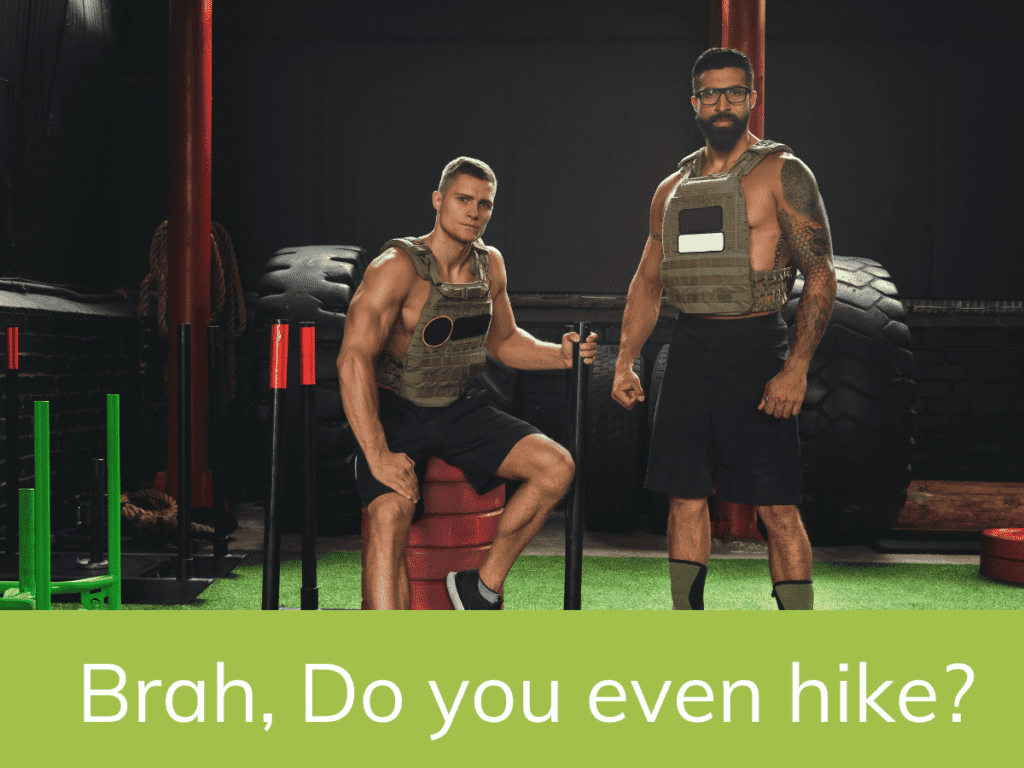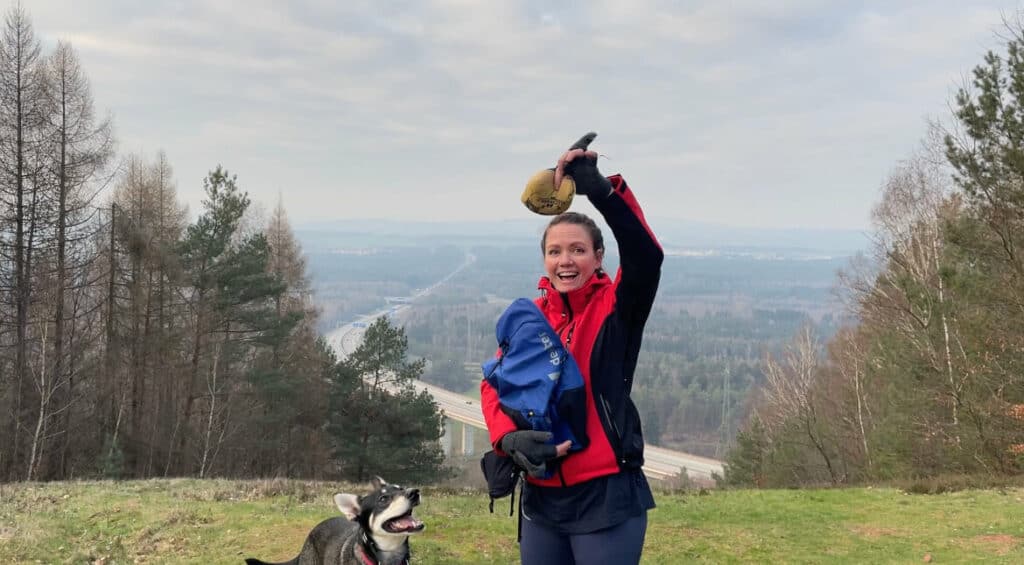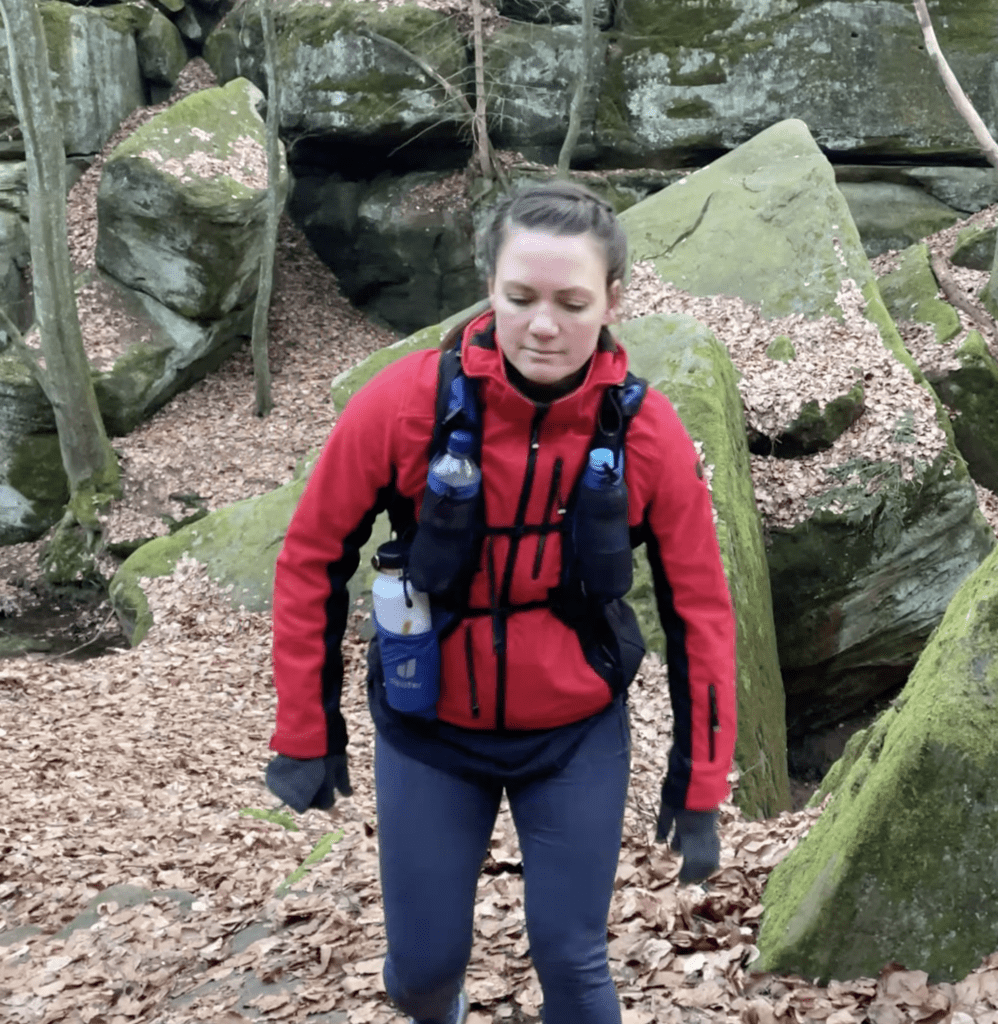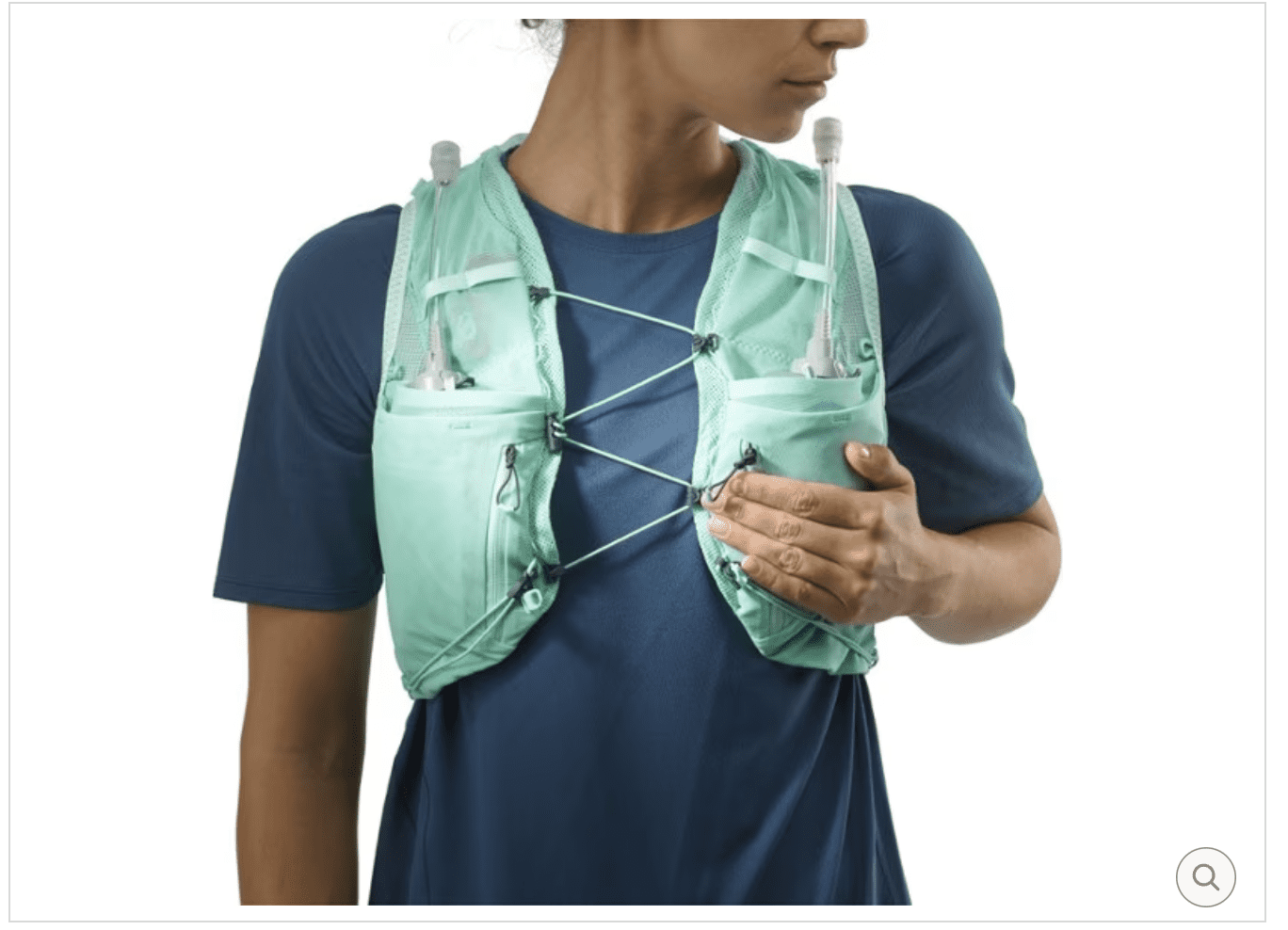
Hiking with a weighted vest is the middle path for building strength and resilience for longer hikes. Are you curious about hiking with a weighted vest? Let’s face it. Hikers usually hate strength training.

We all know that improved strength of the core and lower body muscles can make a huge difference in our levels of muscular fatigue (and thus pain and injury) during a long hike or backpacking adventure.
But you say, I hate the gym and I just love being out in Nature.
This is where I’m going to pull out my masterful physical therapy skills and point out that pretty much any kind or style of strength training offers benefits.
It’s not about the perfect exercise, it’s about the exercise you will actually do.
Hiking with a weighted vest is like strength training without all the barbells and chalk and gym bros.
A weighted vest offers an alternative to lifting weights at home or in the gym. It serves as a convenient tool that you can wear at any time to enhance the type of exercise you actually love while supporting muscle building.
TL;DR: Weighted vests have been shown to improve hiking speed & endurance, power, strength, and bone mineral density. It is important to consider comfort, weight source, and breathability when choosing a weighted vest.
🔥 🥾 Related Reading: Advice From a Hiking Addict Physical Therapist
How to Use Trekking Poles
Hiking with Plantar Fasciitis
How Long Does it Take to Hike 3 Miles?
What You Will Learn
- Quick Verdict : Best Weighted Vest Option for Hikers
- Youtube Hiking With a Weighted Vest Pros and Cons
- Pros and Cons of Using Weighted Vests While Hiking
- Pros of Weighted Vests for Hiking
- Cons of Weighted Vests for Hiking
- How to Decide on Which Kind of Weighted Vest
- Multi-Functional Weighted Vest Solution : Hydration Vests
- How to Hike Safely with Weighted Vests or Hydration Packs
- Top REI Hydration Weighted Vest
- Guidelines for Hydration During a Hike
- FAQ Weighted Vests for Hiking
- More Weighted Vest Articles
- Ready to Experience the Magic of a Hiking Vacation?
Quick Verdict : Best Weighted Vest Option for Hikers
Salomon Adv Skin 12 W Set Hydration Vest - Women's
Benefits of using hydration packs vs standard weighted vests for hiking training include:
- More adjustable straps
- Multiple sizes to ensure snug fit
- Women-centric sizing
- Designed not to bounce
- Less pressure on shoulder blades and collar bones
- Many colors to choose
Comes with 12 liters of capacity. 2 water bottles on front to even out the weight. Multiple pockets, straps and hooks. The water bladder reservoir holds 1.5 liters.
You can attach trekking poles to the bottom of the pack.
Between water weight and additional weight you add into the rear pocket - it's possible to train comfortably with 20-25 lbs with this multi-functional weighted water vest.
It may come as a surprise, but the best “weighted vest” may not be exactly what you’re thinking.
You can deck yourself out in a tactical army style weighted vest that looks like you are ready to start a grueling crossfit workout, or you can simply cross over into the running genre and multi-task with a weighted water vest.
If you’re a hiker, you probably love things that are multi-purpose. And the more you hydrate, the less you have to carry. Win-Win!
Who is this for? A hiker who either 1. Hates the gym 2. Doesn’t have time for the gym but wants to get stronger. 3. Needs to build strength for advanced hiking like “klettersteigs” or “cable assisted” hiking
Who is this not for? Someone trying to build massive quads from training.
It is also important to seek professional advice before starting a new exercise program, especially if you have any health concerns.
Youtube Hiking With a Weighted Vest Pros and Cons
Alternate Way to Build Strength Hiking
Just wear your backpack and load in some water bottles. The problem is that they may jam you in the back. An elegant solution? Cornhole bags! I’m sure you’ve caught the bug of American’s fastest growing sport. Each bag weighs 1 lb, so toss them in your hiking or hydration pack.
Pros and Cons of Using Weighted Vests While Hiking
- Increased calorie burn
- Improved cardiovascular health
- Increased musculoskeletal strength and stability
- Improved bone mass
- Save time working out
- Reduced risk of injury
- Improved balance and proprioception
- Specificity of training: Backpacking
- Strain on lower body joints and cartilage
- Altered breathing patterns due to pack
- Cost
- Chafing around straps
- Increased heat
- Increased pressure on spine
Pros of Weighted Vests for Hiking
According to a study by the American Council on Exercise (ACE), wearing a weighted vest while hiking can increase calorie burn by 12%. This is because the added weight puts additional strain on the body, which in turn requires more energy to be expended.
Additionally, wearing a weighted vest during hiking can help build bone mass and improve musculoskeletal strength, reducing the risk of injury.
Benefits of Weighted Vests
Weighted vest benefits include:
- Increased calorie burn
- Improved cardiovascular health
- Increased musculoskeletal strength and stability
- Improved bone mass
- Save time working out
- Reduced risk of injury
- Improved balance and proprioception
- Specificity of training: Backpacking
What will walking with a weighted vest do according to science?
Weighted vests are a form of added resistance, and the more resistance you have during an exercise, the harder your body has to work. One study showed that people wearing a vest that added 10% of their body weight burned significantly more calories than those not wearing any weight or those carrying only 5% of their body weight.

Weighted vest training has also been shown to have cardiovascular benefits. One study found that wearing a weighted vest improved blood lactate thresholds for runners, allowing them to tolerate faster speeds for longer periods of time before fatiguing.
Weighted vests are also great for increasing strength. Gains have been observed in strength-training exercises such as squats and lunges.
One study showed these vests have even been recommended as training devices for those with osteopenia to improve bone mineral density and reduce the risk of fractures.
Cons of Weighted Vests for Hiking
- Strain on lower body joints and cartilage
- Altered breathing patterns due to pack
- Cost
- Chafing around straps
- Increased heat
- Increased pressure on spine
- Slower Pace
While there are many benefits to wearing a weighted vest during hiking, there are also some potential drawbacks to consider.
The first thing is to be aware of your breathing patterns. This is one of the most beneficial aspects of walking or hiking, the automatic relaxation from engaging in easy, deep and diaphragmatic breath patterns.
There’s a direct signal from your vagus nerve to chill out when you let your diaphragm lead your breath. This means your belly needs to expand outward on your inhale and with a vest, you may inadvertently become chest and neck breath dominant.
This is great if you need to escape a predator or block someone from attacking your jugular, but for most of us a hike is a method to unplug from stress.
Your weighted vest should be adjusted so that you do not feel constricted in your breathing.
The additional weight on the body can increase the impact on the lower body joints. From your toes to your knees, it can increase joint reaction forces by three to four times, increasing the risk of joint injury.

Additionally, the placement of the pack may increase pressure on your spine in ways you are not yet adapted to. It’s important to give yourself time to adapt and frequently adjust and move around an external load like a weighted vest.
Adding weighted vest hiking to your routine will increase your heat output and sweating, so be sure to pad where needed and ensure breathability around your straps. This may even lead to more blisters on your feet, so make sure bring a blister kit for hiking until you know you’ve adapted well.
Ensure you have a layer of merino wool or other natural fiber between the straps and your skin.
It’s important to be careful and follow safety guidelines when using a weighted vest for hiking.
How to Decide on Which Kind of Weighted Vest
Is it okay to walk with a weighted vest?
Standard Weighted Vest
For, as I think I have said, I can only meditate when I am walking. When I stop I cease to think; my mind only works with my legs.
-Rousseau
When choosing a weight vest, consider the weight source, style, comfort, and breathability. Decide on the amount of weight you want to add to your workout and choose a vest that can accommodate that amount.
Consider the length of your workout sessions and choose a vest with comfortable straps and breathable material. Finally, choose a vest that fits your body shape and allows for natural movement during your workout.
- Size and weight
- Breathability
- Comfort and adjustability of straps
- Style
When using a standard weighted vest, it’s important to consider the fit and comfort of the vest, as well as the weight source and breathability.
There are three main styles of standard tactical weighted vests: shoulder holster, tactical, and torso-covering.
There’s also another kind of weighted vest, more on that later.
🌟 Want to buy an adjustable tactical weighted vest? Here’s my recommendation weighted vest recommendations [you can adjust weight gradually and safely].
More Considerations
Some vests are made with the female body in mind, accommodating for differences in body shape such as larger chest sizes.
Some vests come with shoulder pads to keep the straps from digging into the wearer and to increase comfort, especially during longer workout sessions.
Weighted vests come in different weight sources, with some offering a fixed amount of weight, while others have slots in which weights can be added or removed relatively easily.
Some vests are plate-loaded, allowing you to add Olympic-style plates, while others come with specialized plates.
Finally, breathability is an important consideration in weighted vest hiking, as adding weight tends to insulate the body and keep heat in, which can be uncomfortable in hotter climates.
It’s important to choose a vest with breathable material to keep you cool and comfortable during your workout.
Multi-Functional Weighted Vest Solution : Hydration Vests

Benefits of using hydration packs vs standard weighted vests for hiking training include:
- More adjustable straps
- Women-centric sizing
- Designed not to bounce
- Less pressure on shoulder blades and collar bones
Pros of Using Hydration Vest as a Weighted Vest:
The pros and cons of using a hydration vest are similar to traditional weighted vests, but with the upside of multifunctionality, less bouncing and the ability to stay hydrated and decrease your load as you get more fatigued to continue training longer and with proper form.
You’ll be using water as your primary load vs sand or resin. There are pockets to stow gear like phones, keys, etc. In these pockets you could also add small, dense weights to increase the load and difficulty.
Example:
Typical Pack: 10 oz/.3 kg
17 oz/500ml bottle: 1.1 lb or 500 grams
17 oz/500ml bottls: 1.1 lb or 500 grams
84 oz/2.5 liter bladder = 5.5 lbs or 2.5 kg
Before adding weights/phone/etc: 8.3 lbs or 3.75 kg
Now add in some some small soft weights to the pockets or rear compartment: 4 lbs or 1.8 kg
Total = 12.3 lbs or 5.55 kg.
What a nice way to begin training for backpacking that is multifunctional.
➡️ Buy some soft, breathable weights from amazon to stick into the pockets of the hydration bladder.
Cornhole Bags also make great weights.
Cons of Using Hydrations Vest for Hiking Training
The main downside to using a hydration pack vs standard weighted vest is the top limit on weight. You won’t be able to pack as much weight into this as a heavier tactical weighted vest.
So if you want to load more than 20-25 lbs, you’ll want to go with a tactical weighted vest.
How to Hike Safely with Weighted Vests or Hydration Packs
Should I hike with a weighted vest?
Weighted vests are becoming increasingly popular among fitness enthusiasts who hate the confines of a gym, as they provide an effective way to increase resistance and build strength during exercise. One of the most popular activities to do with a weighted vest is hiking. A weighted vest hike can be an effective way to lose weight, build muscle, and improve cardiovascular health.
Is it safe to walk with a weighted vest? Absolutely, it is safe but there are considerations.
- Start gradually
When using a weighted vest for hiking, it’s important to follow the 10% rule, which states that the weight of the vest should be no more than 10% of the individual’s bodyweight. It’s also important to start with a lighter weight and gradually increase over time as the body becomes more acclimated to the added weight.
- Find a vest with proper fit
It’s extremely important to test your gear, but you knew that. When looking to purchase a weighted vest, it is important to consider the cost and budget accordingly. A great option is to look for a used vest through online running groups as this can help save money. It is important to make sure that the vest fits properly and is snug to your body, ensuring that it does not shift during movements and can be used safely. Distribute the weight evenly in your vest.
- Start just once a week
Start with a short hike once a week and see how your body responds. Write down how you feel and if there are any problems. Gradually add duration, intensity and time. Then add more sessions per week.
- Non-Hiking Exercise
A weighted vest is a simple accessory that can be worn during exercise to add extra weight to the body. The added weight puts additional strain on the bones, which causes them to build more mass and density.
This, in turn, leads to improved musculoskeletal strength and stability, reducing the risk of injury. Additionally, wearing a weighted vest during exercise can also boost cardiovascular health and strengthen the lungs and heart.
Start with 3 sets of 10 and perform 2-4 times per week. If you are a beginner, start gradually and work your way toward more challenging sets.
Here are some exercises you can do with a weighted vest:
- Squats: Add resistance to your squats by wearing a weighted vest. This will increase the difficulty of the exercise and work your legs and glutes even harder.
- Pushups: Pushups are a great exercise to do with a weighted vest, as the added resistance
- Step Ups: A hiker can perform a step up by placing one foot on a raised surface while wearing a weighted vest for added resistance.
- Calf Raises: To perform calf raises with a weighted vest, stand with feet hip-width apart, weight evenly distributed, then rise up on the balls of your feet while keeping the knees straight, before lowering back down to starting position.
Top REI Hydration Weighted Vest
There are several options and price points for weighted hydration vests. But my favorite is the multifunctional Salomon Adv Skin 12 W Set Hydration Vest.
Guidelines for Hydration During a Hike
Don’t be like me and drag your toddlers and au pair to the Arches national park in July with only 1.5 liters of water. We did a Claude Dallas and hid under a sagebrush for a half hour to recover on the way back to the car.
This is why I prefer to use a hydration pack loaded with weights vs a tactical weighted vest for training, it reminds me to drink.
- Pre-hydrate: For a sustained fast-paced hike, consider drinking 17–20 fl. oz. about two hours before your hike so you’ll start off properly hydrated.
- Maintain hydration: Drink about 5–10 fl. oz. (or a few good long drinks) of water every 15–20 minutes while hiking.
- Drink after: Post-exercise hydration gets your fluid levels back to normal and can help with recovery. For every pound lost while hiking, drink 16–24 fl. oz. of water.
- Short Hike: If you’re doing a short hike, say one that lasts 45 minutes or less, you may be able to forgo drinking water while you’re out there.
- Hot Weather: But it’s never a bad idea to carry water, especially if it’s really hot outside and you’ll be sweating a lot.
- Carrying Water: Many hikers carry and drink water regardless of how long they’ll be hiking.
FAQ Weighted Vests for Hiking
What muscles does hiking with a weighted vest work?
The primary muscles worked during hiking with a weighted vest are the lower body muscles, including the glutes, quadriceps, hamstrings, and calves, which are responsible for propulsion and stability.
The core muscles, such as the abs and lower back, are also engaged to maintain balance and stability.
Additionally, the upper body muscles, including the shoulders, back, and arms, are used to maintain posture and balance while carrying the weight.
Overall, hiking with a weighted vest can provide a full-body workout, improving strength, endurance, and balance.
Is it good to hike with weights?
Yes, a weighted vest can be a useful tool for those looking to enhance their hiking experience and improve their physical health.
However, it’s important to use caution and follow safety guidelines when using a weighted vest, and to speak with a doctor or fitness professional before starting any new exercise program.
Does hiking with a weighted vest burn more calories?
One study showed that people wearing a vest that added 10% of their body weight burned significantly more calories than those not wearing any weight or those carrying only 5% of their body weight.
Are Weighted Vests Worth it?
It depends. It is especially useful for people that don’t want to perform strength training in the home or gym with traditional weights.
The resistance of the vest can improve your strength, balance and proprioception to reduce risk of injury and increase your hiking capacity.
Should I hike with a weighted vest?
Yes but consider these factors:
Proper Fit: Wearing a weighted vest that is too loose can lead to discomfort and even injury, as it may shift during movements, causing strain on the back, neck, and shoulders.
Weight Distribution: A vest that is not evenly weighted can cause imbalances and increase the risk of injury, particularly to the lower back.
Overloading: Wearing a vest that is too heavy can put unnecessary strain on the body, especially if you are new to using a weighted vest or have pre-existing health conditions like plantar fasciitis. Overloading can also increase the risk of falls and other accidents. It’s important to start with a lighter weight and gradually increase it over time to avoid overloading and injury.
More Weighted Vest Articles
➡️ Review of the best weight vests for women
➡️ Hiking with a weighted vest tips and tricks
➡️ Benefits of weight vest walking
➡️ How to use a weighted vest to lose weight
➡️ Weight vest exercise benefits
➡️ Everything you need to know about weight vests and osteoporosis
➡️ Weighted Vest vs Rucking
➡️ Wearable Resistance
Ready to Experience the Magic of a Hiking Vacation?
Self-Guided Planner for Hut-to-Hut Hiking in Europe
Curious about doing a multi-day hike in the Alps or Dolomites of Europe but not sure where to start? The planning and booking process can be quite challenging as you can’t just go on booking or expedia and reserve your nightly stays.
Trust me, I did it for 14 of my friends one summer and I was so stressed with 3 different spreadsheets and gmail folders trying to keep it all straight. Fortunately there are trail experts, like our friends at Alpenventures Unguided with years of experience managing the reservations, GPS routes and preparing routes for you.
Enjoy a hut to hut hike or even a bike tour by using their booking done-for-you service so you can have a self-guided adventure of a lifetime.
✅ Click here to learn more about 4 day Dolomites Alta Via 1 Adventure. You will need to do a zoom call and discuss the details.
➡️ Click here to learn more about the Full 10 Days on the Alta Via 1. Same thing- you’ll have to spend some time talking about the route with the tour guide on zoom. You may end up wanting a rest day and taking more time.

I hope you enjoyed this hiking with a weighted vest article!

